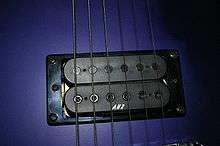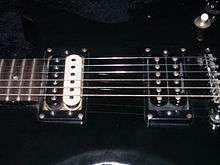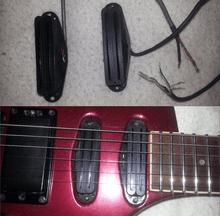Humbucker
A humbucking pickup, humbucker, or double coil, is a type of electric guitar pickup that uses two coils to "buck the hum" (or cancel out the interference) picked up by coil pickups caused by electromagnetic interference, particularly mains hum. Most pickups use magnets to produce a magnetic field around the strings, and induce an electrical current in the surrounding coils as the strings vibrate (a notable exception is the piezoelectric pickup). Humbuckers work by pairing a coil that has the north poles of its magnets oriented "up" (toward the strings) with another coil right next to it with the south pole of its magnets oriented up. By connecting the coils together out of phase, the interference is significantly reduced via phase cancellation: the string signals from both coils add up instead of canceling, because the magnets are placed in opposite polarity. The coils can be connected in series or in parallel in order to achieve this hum-cancellation effect, although it's much more common for the coils of a humbucker pickup to be connected in series (see "series/parallel" below). In addition to electric guitar pickups, humbucking coils are sometimes used in dynamic microphones to cancel electromagnetic hum.


Mains hum is caused by the alternating magnetic fields created by standard AC power, either 60 hertz (USA and Canada) or 50 hertz (most other countries). While playing a guitar without humbuckers, a musician would hear a hum through the pickups during quiet sections of music. Sources of studio and stage hum include high-power amps, processors, mixers, motors, power lines, and other equipment. Compared to single-coil pickups, especially unshielded ones, humbuckers dramatically reduce hum, and (especially when the coils are connected in series) produce a louder signal with more mid-range presence.
History
The "humbucking coil" was invented in 1934 by Electro-Voice, an American professional audio company based in South Bend, Indiana that Al Kahn and Lou Burroughs incorporated in 1930 for the purpose of manufacturing portable public address equipment, including microphones and loudspeakers.[1]
The twin coiled guitar pickup invented by Arnold Lesti in 1935 is arranged as a humbucker, and the patent USRE20070[2] describes the noise cancelation and current summation principles of such a design. This "Electric Translating Device" employed the solenoid windings of the pickup to magnetize the steel strings by means of switching on a short D.C. charge before switching over to amplification.
In 1938, A.F. Knoblaugh invented a pickup for stringed instruments involving two stacked coils (US Pat. 2,119,584). This pickup was to be used in pianos, since he was working for Baldwin Piano at the time.
The 1939 April copy of "Radio Craft Magazine"[3] shows how to construct a guitar pickup made with two identical coils wrapped around self-magnetized iron cores, where one is then flipped over to create a reverse-wound, reverse-polarity, humbucking orientation. The iron cores of these pickups were magnetized to have their north-south poles at the opposite ends of the core, rather than the now more common top-bottom orientation.
To overcome the hum problem for guitars, a humbucking pickup was invented by Seth Lover of Gibson under instruction of then-president Ted McCarty. About the same time, Ray Butts developed a similar pickup that was taken up by Gretsch guitars. Although Gibson's patent was filed almost two years before Gretsch's, Gibson's patent was issued four weeks after Gretsch's. Both patents describe a reverse-wound and reverse-polarity pair of coils.[4][5]
A successful early humbucking pickup was the so-called PAF (literally "Patent Applied For") invented by Seth Lover in 1955.[6] Because of this, and because of its use on the Gibson Les Paul guitar, popularization of the humbucker is strongly associated with Gibson, although humbuckers had been used in many different guitar designs by many different manufacturers before. Humbuckers are also known as dual-coil, double-coil, or hum-canceling pickups. Rickenbacker offered dual coil pickups arranged in a humbucking pattern beginning in late 1953 but dropped the design in 1954 due to the perceived distorted sound, which had stronger mid-range presence. The Gibson Les Paul was the first guitar to use humbuckers in substantial production, but since then, even some models of Fender Stratocasters and Telecasters, traditionally fitted with single-coil pickups, have been factory-equipped with humbuckers. Stratocasters fitted with one humbucker in the bridge position, resulting in a pickup configuration noted as H-S-S (starting at bridge pickup: H for humbucker, S for single coil) are referred to as "Fat Strats", because of the "fatter", "rounder" tone offered by the humbucking pickup.
How humbuckers work
In any magnetic pickup, a vibrating guitar string, magnetized by a fixed magnet within the pickup, induces an alternating voltage across its coil(s). However, wire coils also make excellent antennae and are therefore sensitive to electromagnetic interference caused by alternating magnetic fields from mains wiring (mains hum) and electrical appliances like transformers, motors, and computer screens, especially the older CRT monitors. Guitar pickups reproduce this noise, which can be quite audible, sounding like a constant hum or buzz. This is most noticeable when using distortion, fuzz, compressors, or other effects which reduce the signal-to-noise ratio and therefore amplify the unwanted interference relative to the signal from the strings.
The direction of voltage induced across a coil by the moving string depends on both the coil winding direction and the polarity of the fixed magnet. On the other hand, the direction of current induced by external fields is only dependent on the direction of winding. Therefore, a humbucker has two coils wound in such a way to cancel hum and maximize signal when they are connected. By convention, humbucker coils are both wound counterclockwise; however, typically the outside ends of the coils are connected together so that the coil starts are out of phase. The magnets in the two coils are arranged with opposite polarity so that the string motion induces voltages across both coils that become additive (exactly the opposite of phase cancellation) when the coils are wired in this manner. Electromagnetic interference induces identical, or almost identical voltage across both coils, because they are directly adjacent, and therefore pick up the same interference. When the signals from both coils are summed together, the two noise voltages cancel each other out, while the signal voltages add.[7] This dramatically improves the signal-to-noise ratio. The technique has something in common with what electrical engineers call "common-mode rejection", and is also found in the balanced lines used in audio equipment.
The arrangement of the humbucker coils to achieve reverse current flow with opposite magnetic polarity in each coil is known as Reverse Wound, Reverse Polarity, or RWRP for short. This nomenclature does not indicate that the coils are wound in opposition, but that the current flows in opposition.


Alternative humbucker designs
Mini-humbuckers
Many solid-body guitars feature cavities only for single-coil pickups. Installing full-sized humbuckers in this type of guitar requires additional routing of the woodwork, and/or cutting of the pickguard if the instrument has one. If the process is not carefully done, the instrument's body and pickguard may be damaged. For many guitarists, this is unacceptable, especially for expensive vintage guitars where it is vital to preserve cosmetic appearance. As a result, many pickup manufacturers now produce humbucking pickups compacted into the size of a single coil. Many different kinds of mini-humbuckers are available from numerous manufacturers, and they produce a wide range of different tones. The most common design is very similar to a traditional humbucker.
Stacked coils
As a concept similar to mini-humbuckers, a stacked pickup offers the more subtle and delicate sound of a single-coil, while still retaining the hum-cancellation properties of a humbucker. One of the coils simply has no magnets, so the inverted signal of this coil only serves to cancel out the hum picked up by the other coil, with the actual string signal remaining unaffected. This is often used on bass guitars, where the type of pickups used has a more substantial effect on the instrument's overall sound, and the lower range of note fundamental frequencies can match frequencies typically more heavily affected by hum. This is often called a "stacked" pickup, because the coils are most often "stacked" vertically, with the coil containing magnets placed closer to the strings.
Rail humbuckers
Another design known as the rail humbucker features a single magnetic component spanning across the entire string width of the instrument. These pickups look like a normal mini-humbucker, except without the typical dots corresponding to the magnetic pole-pieces. This is sometimes expanded into a normal-size "quadrail", or double humbucker, effectively combining 4 coils connected in series to produce an extremely high-output pickup. The Kent Armstrong "Motherbucker" is an example of such an overpowered pickup.
The same type of rails can also be found in a normal-size humbucker, however. Heavy metal guitarist Dimebag Darrell made heavy use of this type of pickup wired in the bridge position. These tend to also sound fuller and have a higher output and bass response than the single coil-size version. Dimarzio has designed and sold many such pickups.
Coil splits and coil taps
Some guitars which have humbucking pickups feature "coil splits", which allow the pickups to act as "pseudo-single" coils by either short-circuiting or bypassing one coil. The electrical circuit of the pickup is reduced to that of a true single coil so there is no hum canceling effect. Usually, this feature is activated using a miniature toggle switch or a DPDT push-pull switch mounted on a potentiometer. Some guitars (e.g., the Peavey T-60 and the Fender Classic Player Jaguar HH) make use of a variable coil split circuit that allows the guitarist to dial a variable amount of signal from the second coil, from pure single-coil to full humbucker and everything in-between.
Another similar option is a series/parallel switch, which in one position causes the coils to be connected in parallel rather than in series. This retains the humbucker's noise-cancellation properties, and gives a sound closer to that of two single-coil pickups used together.
Coil splits are often wrongly referred to as a "coil tap". Coil taps are most commonly found on single coil pickups, and involve an extra hook-up wire being included during the manufacture of the pickup so the guitarist can choose to have all the windings of the pickup included in the circuit, for a fatter, higher output sound with more midrange; or switch the output to "Tap" into the windings at a point that is less than the full coil for a brighter, lower output, cleaner sound. For example: a full pickup coil may be 10,000 turns of wire and the "Tap" may be at 8000 turns. Because of the confusion between coil splits and coil taps—and the rareness of coil taps in general—it is difficult to find tappable single coil pickups for sale. However, pickup manufacturer Seymour Duncan offers tapped versions of many of their Telecaster and Stratocaster pickups.
Notable humbucker designs
- Gibson "PAF" - Seth Lover's humbucker design
- Gretsch Filter'Tron Prototype – Ray Butts' first humbucker design[8][9]
- Fender Wide Range – Fender's first humbucker design, also by Seth Lover
- Epiphone (and later Gibson) mini-humbucker – a smaller humbucker design with adjustable pole pieces. A Gibson design which reduced their standard humbucker to fit in Epiphones routed for the 1950s Epi "New York" pickup, they were later used most famously in the Gibson Les Paul Deluxe.
- Gibson Firebird pickup – inspired by the Epiphone pickup, and shares its basic dimensions, but is different in terms of design, appearance, and tone, using single blade pole pieces.
- Q-tuner – neodymium magnet humbuckers
- EMG Pickups – active pickups since 1976
- Seymour Duncan - by Seymour W. Duncan
Other noise-reducing pickup designs
While the original humbucker remains the most common noise-reducing pickup design, inventors have tried many other approaches to reducing noise in guitar pickups.
Combining two single-coil pickups
Many instruments combine separate single coil pickups in a hum reducing configuration by reversing the electrical phase of one of the pickups. This arrangement is similar to that of a humbucking pickup and effectively reduces noise. Examples of this include the Fender Jazz Bass, introduced in 1960, which has used a pair of single coil pickups, one near the bridge and another one about halfway between the bridge and the neck—and many Stratocaster style guitars, which often have 3 pickups with the middle one reversed electrically and magnetically. The (usually) five-way selector switch provides two humbucking settings, using the reversed middle pickup in parallel with either the bridge or neck pickup.
If the pickups are wired in series instead of parallel, the resulting sound is close to that of a normal humbucker. It is even closer to a humbucker-type sound if you put the coils closer together.
Proprietary designs

In 1957, Fender introduced a split pickup to its Precision Bass, where one coil is serving the E and A strings, and the other one the D and G strings. This configuration is often referred to as a "split coil" pickup, which should not be confused with the possibility of "coil-splitting" a regular humbucker as discussed above. Both coils see nearly identical extraneous electromagnetic disturbances, and since they are wired in humbucking fashion, can effectively cancel them. However the majority of the sound signal of any single note will mostly be generated just by one of the coils, so that output level and tonal qualities are much closer to a regular single-coil pickup. The resulting "P-Style" pickup is usually regarded as the main ingredient of the "P-Bass" sound, and many variants of the design are being offered by many manufacturers. The concept was later developed into G&L's "Z-coil" pickup, which is used for standard guitars such as their Comanche model.
In 1985, Lace Music Products introduced the Lace Sensor pickup, which uses proprietary screened bobbins to reduce hum while preserving single-coil tone.[10]
In the early 1980s DiMarzio introduced replacement pickups for Stratocaster and Telecaster guitars. These were of the stacked humbucker design, where the lower pickup coil functions solely to cancel hum.
See also
- Pickup (music technology)
- Single coil
References
- Mix, June 17, 2005. "Al Kahn (1906–2005)" Archived 2010-12-26 at the Wayback Machine. Retrieved on August 24, 2009.
- https://docs.google.com/viewer?url=patentimages.storage.googleapis.com/pdfs/USRE20070.pdf
- Kendall Ford "A Home-Made String-Music Pickup" Radio Craft Magazine, April 1939 p.601,624-5.
- "Patent US2896491 - Magnetic pickup for stringed musical instrument". google.com.
- "Patent US2892371 - Pickup". google.com.
- "Seth Lover interview 1978 vintage Gibson PAF humbucking humbucker pickups guitars". Provide.net. Retrieved 2013-05-02.
- Lawrence, Robb. The Early Years of the Les Paul Legacy 1915-1963. Hal Leonrd Corp. p. 107.
- By Rich Kienzie, "Riffs, Amps, and Butts", Guitar Player magazine, March 1990, P.14
- Joseph Raymond Butts, U.S. Patent 2892371, Issued 6-22-1959
- "Archived copy". Archived from the original on 2013-11-24. Retrieved 2013-12-02.CS1 maint: archived copy as title (link)
- US patent 2896491, Seth Lover, "Magnetic pickup for stringed musical instrument", issued 1959-07-28
External links
| Wikimedia Commons has media related to Humbucker. |